RainAlert III
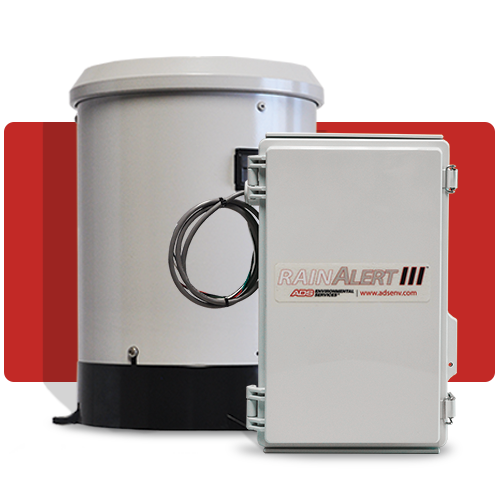
The ADS® RainAlert® III is a cost-effective, wireless rain gauge that alerts operators via text or email messages when rainfall intensity exceeds a critical threshold. Priced for deployment as a stand-alone unit or part of a comprehensive monitoring network, the enclosure is suitable for ground-level, pole-mount or rooftop installation. The RainAlert III connects to an ADS or customer supplied tipping bucket. Rainfall totals are time-stamped and stored at one-minute intervals or greater based on customer-supplied specifications. It is easily configured and managed using ADS’s Qstart™ and PRISM™ software and allows instant access for retrieval of logged rain and alarm data.
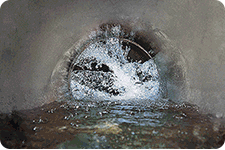
RainAlert III Applications
The ADS RainAlert III is used to collect and alarm on precipitation data for use in many applications, including precipitation analysis, infiltration/Inflow programs, rainfall insight for CSO and SSO monitoring, sewer capacity studies, rehabilitation effectiveness, sewer master plan studies, and early warning and notification based on rain intensity.

RainAlert III Benefits
The RainAlert III provides rainfall data acquisition, precipitation analysis, and smart alarming to support wastewater capital improvement, operations and maintenance, and regulatory programs.
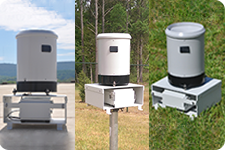
Easy to Install and Configure
Easily configured and managed using ADS Qstart software. The RainAlert III provides 100% compatibility with ADS FlowView PRISM software for accessing and managing all alarm events, alarm history, and stored rain data via the Web. It is designed for ground-level, pole-mount, and rooftop installations.
Download Datasheet // PURCHASE ON STOREFRONT
RainAlert III Resources
Literature
Product Manual
Setup Guides
Firmware and Software
Literature
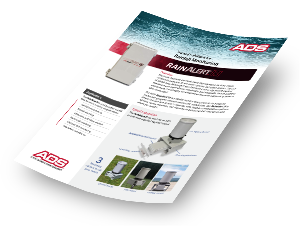
RainAlert III Literature Downloads
>> RainAlert III Literature
>> TB3 TIPPING BUCKET
>> TB4 SERIES II TIPPING BUCKET
>> TB7 TIPPING BUCKET
Product Manual
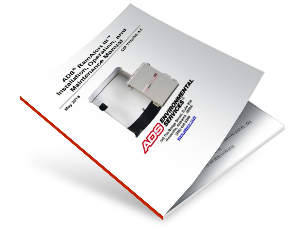 RainAlert III Product Manual Download
RainAlert III Product Manual Download
Installation, Operation and Maintenance
#QR775030 A6 (August 2022)
>> Download the RainAlert III Product Manual
Setup Guides
Programs to Configure and Activate Your RainAlert III
>>RainAlert III Startup Guide
Set up your ADS RainAlert III before field Installation.
>>RainAlert III QstartXML Quick Reference Guide
Step-by-step instructions on how to configure and activate the ADS RainAlert III using QstartXML.
>>QstartXML
Startup and configuration software included with your purchase of RainAlert III.
>>Qstart
Legacy startup and configuration software included with your purchase of RainAlert III.
>>Activation Instructions For Customer Using Their Own Verizon Wireless Network
Step-by-step instructions for RainAlert III activation when using your own Verizon wireless network.
Firmware and Software
Updates to Firmware and Software
All updates to RainAlert III firmware can be accessed through the ADS Software Downloads page. The RainAlert III is compatible with ADS’s PRISM advanced cloud-based software. Transform your rainfall monitoring data into actionable insight when combining the ADS RainAlert III with PRISM. Always stay informed by regularly visiting the PRISM Updates page.
>>Software Downloads
>>PRISM
>>QstartXML
Startup and configuration software included with your purchase of the ADS RainAlert III.
>>Qstart
Legacy startup and configuration software included with your purchase of the ADS RainAlert III.
RainAlert III FAQs
Q1. What software is needed to setup the ADS® RainAlert™ III monitor?
A1. The ADS Qstart™XML (or Qstart) software is needed and is available for download on the ADS Software Downloads For further instructions regarding installing the QstartXML software, download the QstartXML Installation Guide also on the software downloads page.
Q2. How should the RainAlert III be configured and activated?
A2. All steps necessary for a successful configuration and activation of the RainAlert III are outlined in Chapter 3 of the RainAlert III Installation, Operation, and Maintenance Manual or view the “How To Initialize an ADS RainAlert III Rainfall Monitor” video.
Q3. How can the monitor be configured to send out/files/manuals/RainAlertIII-Combined_A5.pdf alarms?
A3. The monitor can be configured to send out alarms through the Rain and Data Delivery devices in QstartXML. Further information on how to configure these devices is available in QstartXML’s online help or in Chapter 3 of the RainAlert III Installation, Operation, and Maintenance Manual.
Q4. Can the RainAlert III be configured to deliver data to ADS PRISM?
A4. Yes. The RainAlert III can be configured to deliver data to PRISM using the Data Delivery device in QstartXML. The server IP address is 13.82.147.226.
Q5. Can the RainAlert III deliver data simultaneously to an FTP server and ADS PRISM?
A5. Yes, provided the Data Delivery device in QstartXML has been configured to deliver data to both locations.
Q6. Why is the RainAlert III unable to deliver files to the FTP server after configuration?
A6. The folder name configured on the Data Delivery device cannot have spaces in the name. For example, RAIII Folder will not work, but RAIII_Folder will work. Verify that there are no spaces in the folder name and activate the RainAlert III again to see if it successfully delivers files to the FTP server. Other possibilities for this error could be that the FTP server is not configured to accept file delivery from the RainAlert III’s IP address, or that the RainAlert III is set to Active for the delivery mode and needs to be set to Passive in the Data Delivery ADS recommends using the Passive delivery mode.
Q7. What is the difference between Active and Passive mode on the Data Delivery device in the FTP setup section?
A7. The Active mode allows the monitor to set the data channel (port) for the FTP server to use; in the Passive mode, the FTP server tells the monitor which port to send the data over. Most servers are configured to accept data in the Passive mode only. Therefore, ADS recommends using this mode unless the FTP server does not support it.
Q8. Can the RainAlert III deliver data via email?
A8. Yes. On the Notification page of the Advanced device, the Recipient 5 can be configured to receive data via email.
Q9. Can the RainAlert III be configured to respond to on-demand remote communication requests?
A9. Yes. On-demand, remote communication is available for monitors equipped with SIM cards having static IP addresses as long as the modem power is configured to be “on.” Further information on configuring on-demand data collection is available in Chapter 3 of the RainAlert III Installation, Operation, and Maintenance Manual.
Q10. Can the RainAlert III’s initial activation be done wirelessly?
A10. No. The monitor must be activated initially on-site via direct connection to the monitor using the Serial option for the Connect parameter in QstartXML. Subsequent activations can occur wirelessly.
Q11. Is the ADS sun shield needed for all installations?
A11. ADS recommends all outdoor installations use the sun shield to maximize the life of the monitor enclosure.
Q12. What parts, supplies, and equipment are needed to install the RainAlert III?
A12. The following parts and supplies are required: RainAlert III monitor, tipping bucket, sun shield, direct connection cable, pole-mount kit (if securing the sun shield to a pole), calibration kit (for the tipping bucket). The following tools and equipment are required: 24” (610 mm) carpenter’s level, open-end wrench set (including ½ – ¾-inch sizes), small adjustable crescent wrench, flathead and Phillips head screwdrivers (assorted sizes, included 1/8-inch tip flathead), diagonal wire cutters and strippers, ladder (if needed).
Q13. Does the RainAlert III support an external antenna?
A13. Yes. ADS offers an external antenna kit (ADS p/n 9000-0044), and further information on the installation and use of an external antenna can be found in Appendix C of the RainAlert III Installation, Operation, and Maintenance Manual.
Q14. Can a user communicate remotely with a deactivated RainAlert III?
A14. No. Once the monitor has been deactivated, users can no longer communicate remotely. In order to reinitialize communications, it must be activated again on-site with a direct serial connection.
Q15. Does the RainAlert III support Verizon wireless communications?
A15. Yes. As of May 2018, the ADS Verizon LTE-M RainAlert III monitor has been available for purchase.
Q16. How long will a RainAlert III battery last?
A16. The monitor’s battery can last between four months to five years, depending on the configuration of Modem Power Settings, the frequency of the Data Delivery configuration, etc. Maximum battery life is obtained when the Modem Power is configured to be Always Off.
Q17. What is the low battery threshold for a RainAlert III?
A17. The low battery threshold is 6.0 volts. It is recommended that the battery be changed within two weeks of receiving the low battery warning.
Q18. How can ADS Customer Support be contacted?
A18. ADS Customer Support can be contacted through email at adssupportcenter@idexcorp.com, or by telephone at 1-877-237-9585 (for U.S. customers) or 256-430-6234 (for customers outside the U.S.).
Q19. Does the RainAlert III support external power?
A19. Yes. Appendix D in the RainAlert III Installation, Operation, and Maintenance Manual provides information on the installation and use of an external power source.
Q20. Will the internal real-time clock of the RainAlert III drift?
A20. No. The internal clock of the RainAlert III is checked every 12 hours and compared to the cellular network time. If the internal RainAlert III clock differs by more than 5 seconds, it is resynchronized to the cellular network time.
Q21. Are there resources for Maintenance and/or Troubleshooting issues with the RainAlert III?
A21. Yes. Chapter 6 in the RainAlert III Installation, Operation, and Maintenance Manual provides information on many topics regarding Maintenance and Troubleshooting.
Rainfall Monitoring Technical Papers
- Elements to Successful Rainfall Monitoring – Rain Gauge Equipment Selection for the Urban Sewer Environment
- Elements to Successful Rainfall Monitoring – Rain Gauge Equipment Selection for the Urban Sewer Environment (Metric)
- Elements to Successful Rainfall Monitoring – Rain Gauge Siting Principles for the Urban Sewer Environment
- Elements to Successful Rainfall Monitoring – Rain Gauge Siting Principles for the Urban Sewer Environment (Metric)
RainAlert III Videos
Instructional Video: How to Initialize the ADS RainAlert III (Qstart XML)
How to Replace a Battery Pack in an ADS RainAlert III Rainfall Monitor
How to initialize ADS RainAlert III Rainfall Monitor (Qstart)
Webinar Archive Videos
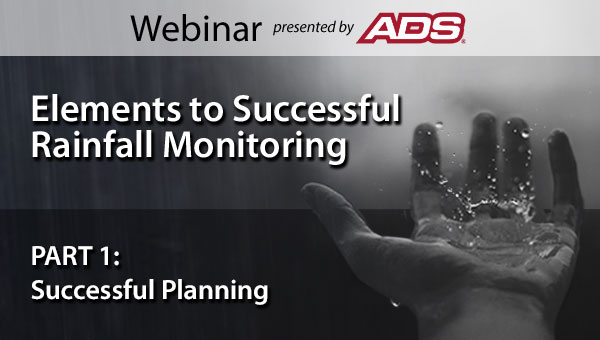
SPEAKER: Kevin Enfinger, P.E.
See how selecting the right equipment in the right quantities for your local rainfall conditions and your specific applications will lead to a successful rainfall monitoring program.
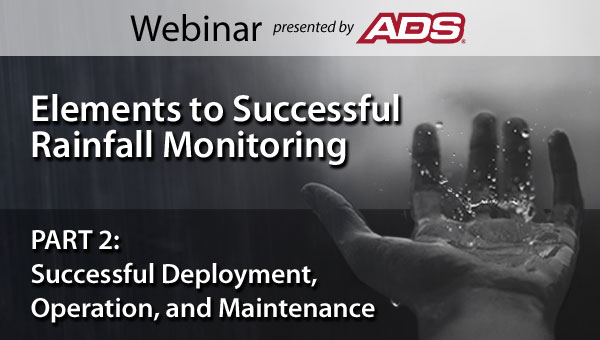
SPEAKER: Kevin Enfinger, P.E.
See how proper installation and maintenance practices will contribute to a successful rainfall monitoring program.
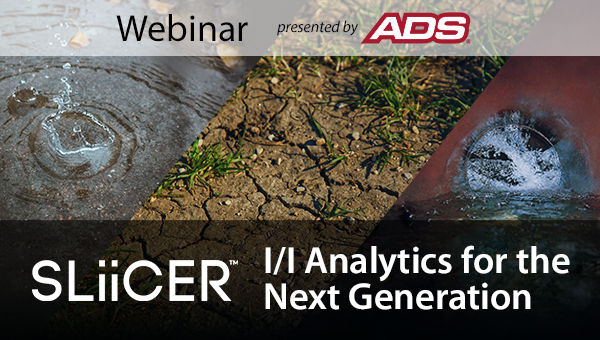
SPEAKER: Kevin Enfinger, P.E.
SLiiCER™ makes it easy to evaluate your entire collection system as a single solution, tracking down I/I to guide rehabilitation programs, eliminate overflows, and validate results.
Request Access to Archive
